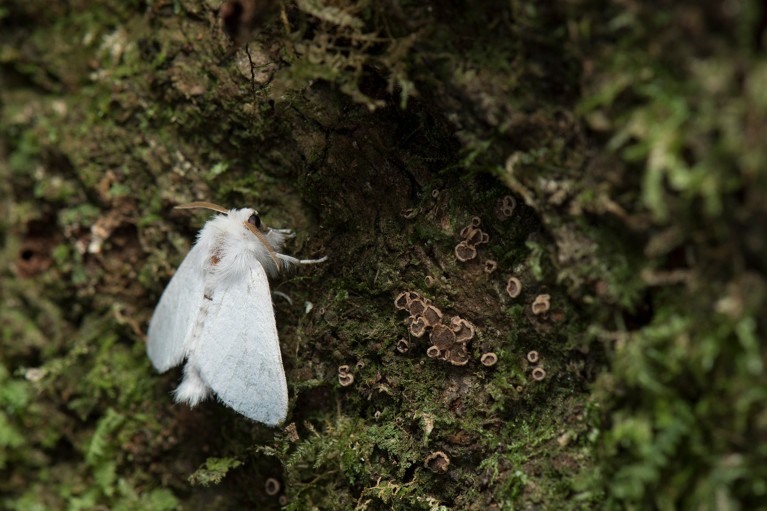Hello Nature readers, would you like to get this Briefing in your inbox free every day? Sign up here.
A moth from the Gazalina genus. An unidentified type of white moth, perhaps a species of Gazalina, has been linked with outbreaks of a debilitating eye disease in Nepal.Credit: Licheng Shih via iNaturalist (CC BY 4.0)
Are these moths blinding children?
Researchers in Nepal are carrying out environmental surveys and genomic sequencing to determine the cause of an eye infection that can cause children to lose their vision within days. Cases of seasonal hyperacute panuveitis seem to spike every two years, baffling scientists. Now researchers are racing to examine a possible link with white moths of the genus Gazalina, which swarm through Nepal at the end of the monsoon season — but funding is scarce.
Nature | 6 min read
Egg-cell ‘lattice’ linked to infertility
Cytoplasmic lattices — mysterious bundles of fibres that float in mammalian egg cells — seem to be storage sites for many proteins that are essential for the development of the early embryo. The discovery could explain why people whose eggs lack the fibres entirely are infertile. When researchers disabled the genes in mice that encode the proteins that make up the fibres, the resulting embryos were nonviable. “It was a revelation,” says biochemist Melina Schuh, who co-authored the research.
Nature | 3 min read
Reference: Cell paper
How to catch a falling star
When the OSIRIS-REx capsule re-entered Earth’s atmosphere with its sample of the asteroid Bennu, it compressed the air in front of it like a piston, creating a glowing, superheated plasma of ionized gas and a double sonic boom. Scientists eagerly gathered data from this unusually predictable hypersonic event using aeroplanes, balloons, seismometers and other equipment along the trajectory. They aim to better understand the energetics of incoming meteors, such as the asteroid that exploded above Chelyabinsk, Russia, in 2013.
Nature | 4 min read
Weaponized antibodies target cancer
A combination of two drugs cuts the risk of death in people with bladder cancer by more than half, compared with conventional chemotherapy. It’s an unprecedented result in a cancer for which survival rates have been almost unchanged since the 1980s. The treatment consists of pembrolizumab, which allows the body to attack tumours more effectively, and an antibody–drug conjugate, enfortumab vedotin, which delivers a toxic agent directly to cancer cells.
Nature | 5 min read
We are busting our carbon budget
Earth could be committed to breaching 1.5 °C of warming — the Paris climate agreement’s aspirational limit — by 2029, rather than the mid-2030s. A new estimate slashes our ‘carbon budget’ — the amount of CO2 that we can emit to have a 50% chance of limiting global warming to 1.5 ℃ — in half compared with the last report from the United Nations Intergovernmental Panel on Climate Change (IPCC). Taking into account the latest data and our best understanding of the factors that influence warming, we’ve got around 250 gigatonnes left. And we’re burning through that globally, at the rate of 40 gigatonnes each year. Ultimately, the take-home message remains the same: every minute counts. “Every ton of carbon dioxide saved is all the more important because the budget is so extremely tight,” says climatologist Niklas Höhne. “Even if the multi-year average temperature increase exceeds 1.5 °C … every ton saved leads to less global temperature increase and therefore less damage.”
BBC | 5 min read
Reference: Nature Climate Change paper

The IPCC set a carbon budget of 494 gigatonnes of CO2 from 2020 to successfully limit warming to 1.5 ℃. A new estimate revises that to 247 gigatonnes, from this January. The blue region shows scenarios defined by the Network for Greening the Financial System (NGFS), a network of banks and financial supervisors aimed at accelerating the adoption of green finance, that would keep us near the target. The yellow line is what countries’ climate promises would achieve, and the red region is what current policy scenarios would actually deliver. (Nature Climate Change News & Views article | 7 min read)
Features & opinion
Five best science books this week
Andrew Robinson’s pick of the top five science books to read this week includes why we fall for scams, an homage to sustainable design and a vivid memoir of why the mayor of London decided to go all-in against air pollution.
Nature | 4 min read
Close entanglement of the third kind
A celestial custodian transforms discarded ideas and notions into unexpected treasures in the latest short story for Nature’s Futures series.
Nature | 6 min read
Podcast: A muscle-regenerating gel
An injectable prosthesis could help to heal damaged muscles. It’s made from a conductive hydrogel, which means the muscle can be electrically stimulated to promote healing. In this week’s Nature Podcast, biomedical engineer and study co-author Mikyung Shin explains how the material rapidly restored injured rats’ ability to walk and regenerated muscles within just four weeks.
Nature Podcast | 23 min listen
Subscribe to the Nature Podcast on Apple Podcasts, Google Podcasts or Spotify, or use the RSS feed.
